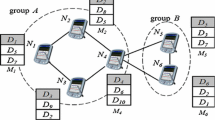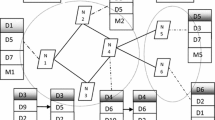Abstract
Due to the continuous mobility of hosts, an ad hoc network suffers from frequent disconnections. This phenomenon is undesirable when mobile hosts are accessing data from each other, and thus, data accessibility is lower than that in conventional fixed networks. Because one cannot control network disconnections, an alternative solution to this problem is to replicate data objects onto mobile hosts so that when disconnections occur, mobile hosts can still access data. In this paper, a mathematical model for data object replication in ad hoc networks is formulated. The derived model is general, flexible and adaptable to cater for various applications in ad hoc networks. We prove that this problem in general is NP-complete and propose a game theoretical technique in which players (mobile hosts) continuously compete in a non-cooperative environment to improve data accessibility by replicating data objects. The technique incorporates the access frequency from mobile hosts to each data object, the status of the network connectivity, and communication costs. In the proposed scheme, players (mobile hosts) compete through bids in a non-cooperative environment to replicate data objects that are beneficial to themselves and the system as a whole. To cater for the possibility of cartel type behavior of the players, the scheme uses the Vickrey payment protocol that leaves the players with no option than to bid in such a fashion that is beneficial to the system as a whole. The paper also identifies some useful properties of the proposed scheme and the necessary conditions of optimality. The proposed technique is extensively evaluated against some well-known ad hoc network replica allocation methods, such as: (a) randomized, (b) extended static access frequency, (c) extended dynamic access frequency and neighborhood, and (d) extended dynamic connectivity grouping. The experimental results reveal that the proposed approach outperforms the four techniques in solution quality and projects a competitive execution time.
Similar content being viewed by others
References
Apers P (1988) Data allocation in distributed database systems. ACM Trans Database Syst 13(3):263–304
Archer A, Tardos E (2001) Truthful mechanisms for one-parameter agents. In: Proc of 42nd IEEE annual symposium on foundations of computer science, 2001, pp 482–491
Arrow K (1950) A difficulty in the concept of social welfare. J Political Econ 58(4):328–346
Barbara D, Imielinski T (1994) Sleepers and workaholics: caching strategies in mobile environments. In: Proc of ACM SIGMOD, 1994, pp 1–12
Bayati A, Ghodsnia P, Basseda R, Rahgozar M (2006) A novel way of determining the optimal location of a fragment in a DDBS: BGBR. In: Proc of international conference on systems and networks communication (ICSNC), 2006
Casey R (1972) Allocation of copies of a file in an information network. In: Proc spring joint computer conf, IFIPS, 1972, pp 617–625
Cay J, Tan KL, Ooi BC (1997) On incremental cache coherency schemes in mobile computing environments. In: Proc of IEEE ICDE, 1997, pp 114–123
Chu W (1969) Optimal file allocation in a multiple computer system. IEEE Trans Comput C-18(10):885–889
Crovella M, Bestavros A (1997) Self-similarity in world wide web traffic: evidence and possible causes. IEEE/ACM Trans Netw 5(6):835–846
Eswaran K (1974) Placement of records in a file and file allocation in a computer network. Inf Process Lett 304–307
Garey M, Johnson D (1979) Computers and intractability. W.H. Freeman, New York
Gerbia HA, Cenan C (2005) Distributed database replication—a game theory? In: Proc of 7th international symposium on symbolic and numeric algorithms for scientific computing, 2005
Grassi V (2000) Prefetching policies for energy saving and latency reduction in a wireless broadcast data delivery system. In: Proc of ACM international workshop on modeling, 2000, pp 77–84
Hara T (2001) Effective replica allocation in ad hoc networks for improving data accessibility. In: Proc of IEEE INFOCOM, 2001, pp 1568–1576
Hara T (2003) Replica allocation in ad hoc networks with data update. Mobile Netw Appl 8:343–354
Hara T, Madria SK (2004) Dynamic data replication using aperiodic updates in mobile ad hoc networks. In: Proc of 9th international conference on database systems for advance applications, 2004, pp 869–881
Huang Y, Sistla P, Wolfson O (1994) Data replication for mobile computer. In: Proc of ACM SIGMOD, 1994, pp 13–24
Jing J, Elmagarmid A, Helal A, Alonso R (1997) Bit-sequences: an adaptive cache invalidation method in mobile client/server environments. Mobile Netw Appl 2(2):115–127
Johnson DB (1994) Routing in ad hoc networks of mobile hosts. In: Proc of IEEE workshop on mobile computing systems and applications, 1994, pp 158–163
Khan SU, Ahmad I (2004) Heuristic-based replication schemas for fast information retrieval over the Internet. In: Proc of 17th international conference on parallel and distributed computing systems, 2004, pp 278–283
Khan SU, Ahmad I (2005) A powerful direct mechanism for optimal WWW content replication. In: Proc of 19th IEEE International parallel and distributed processing symposium, 2005
Khan SU, Ahmad I (2005) RAMM: a game theoretical replica allocation and management mechanism. In: 8th International symposium on parallel architectures, algorithms, and networks (I-SPAN), Las Vegas, NV, USA, December 2005, pp 160–165
Khan SU, Ahmad I (2006) A pure nash equilibrium guaranteeing game theoretical replica allocation method for reducing web access time. In: 12th international conference on parallel and distributed systems (ICPADS), Minneapolis, MN, USA, July 2006, pp 169–176
Khan SU, Ahmad I (2006) Replicating data objects in large-scale distributed computing systems using extended Vickery auction. Int J Comput Intell 3(1):14–22
Khan SU, Ahmad I (2007) Discriminatory algorithmic mechanism design based WWW content replication. Informatica 31(1):105–119
Khan SU, Ahmad I (2009) A pure Nash equilibrium-based game theoretical method for data replication across multiple servers. IEEE Trans Knowl Data Eng 20(3):346–360
Loukopoulos T, Ahmad I, Papadias D (2002) An overview of data replication on the Internet. In: Proc of ISPAN, 2002, pp 31–36
Mahmoud S, Riordon J (1976) Optimal allocation of resources in distributed information networks. ACM Trans Database Syst 1(1):66–78
Nisan N, Ronen A (1999) Algorithmic mechanism design. In: Proc 31st annual ACM symposium on theory of computing (STOC ’99), 1999, pp 129–140
Osborne M, Rubinstein A (1994) A course in game theory. MIT Press, Cambridge
Pearlman MR, Haas ZJ (1999) Determining the optimal configuration for the zone routing protocol. IEEE J Select Areas Commun 17(8):1395–1414
Perkins CE, Bhagwat P (1994) Highly dynamic destination-sequenced distance-vector routing for mobile computers. In: Proc of ACM SIGCOMM, 1994, pp 234–244
Perkins CE, Royer EM (1999) Ad hoc on demand distance vector routing. In: Proc of IEEE workshop on mobile computing systems and applications, 1999, pp 90–100
Pitoura E, Bhargava B (1995) Maintaining consistency of data in mobile distributed environments. In: Proc of IEEE ICDCS, 1995, pp 404–413
Rappaport TS (1996) Wireless communications: principles and practices. Prentice Hall, New York
Saurabh S, Parkes D (2004) Hard-to-manipulate VCG-based auctions. Technical Report, Harvard University
Shannon CE (1949) The mathematical theory of information. University of Illinois Press, Urbana, 1949
Vickrey W (1961) Counterspeculation, auctions and competitive sealed tenders, J Finance 8–37
Wu KL, Yu PS, Chen MS (1996) Energy-efficient caching for wireless mobile computing. In: Proc of IEEE ICDE, 1996, pp 336–343
Zipf G (1949) Human behavior and the principle of least-effort. Addison-Wesley, Cambridge
Author information
Authors and Affiliations
Corresponding author
Rights and permissions
About this article
Cite this article
Khan, S.U. Mosaic-Net: a game theoretical method for selection and allocation of replicas in ad hoc networks. J Supercomput 55, 321–366 (2011). https://doi.org/10.1007/s11227-009-0329-y
Received:
Accepted:
Published:
Issue Date:
DOI: https://doi.org/10.1007/s11227-009-0329-y




